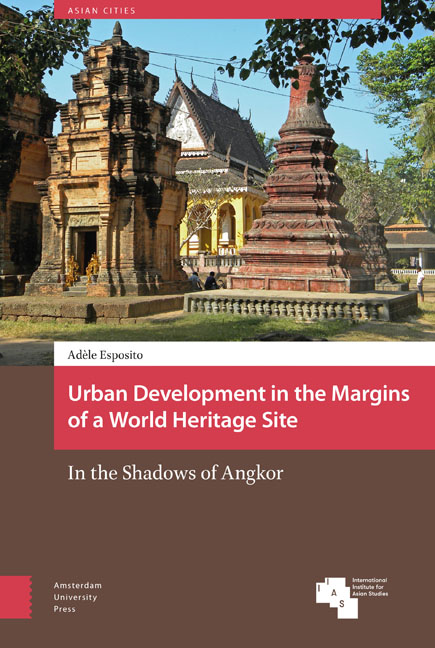Book contents
- Frontmatter
- Dedication
- Contents
- List of Figures
- Abbreviations
- Glossary of Khmer terms
- Acknowledgements
- Author’s Preface
- Introduction
- 1 ‘Before you Build a Wall, Think of What You are Leaving Outside it’: The Construction of Core and Marginal Spaces in the Angkor Region
- 2 The Arena of Urban Planning and the Idea of the City
- 3 The City as Developers’ Playground
- 4 The Architectural Space: How Contemporary Design Shapes Urban Identities and Ideas of Modernity
- Conclusion
- Bibliography
- Index
- Publications / Asian Cities
4 - The Architectural Space: How Contemporary Design Shapes Urban Identities and Ideas of Modernity
Published online by Cambridge University Press: 16 February 2021
- Frontmatter
- Dedication
- Contents
- List of Figures
- Abbreviations
- Glossary of Khmer terms
- Acknowledgements
- Author’s Preface
- Introduction
- 1 ‘Before you Build a Wall, Think of What You are Leaving Outside it’: The Construction of Core and Marginal Spaces in the Angkor Region
- 2 The Arena of Urban Planning and the Idea of the City
- 3 The City as Developers’ Playground
- 4 The Architectural Space: How Contemporary Design Shapes Urban Identities and Ideas of Modernity
- Conclusion
- Bibliography
- Index
- Publications / Asian Cities
Summary
The previous chapter examined the conflicts between different parties that underpin the transition of Siem Reap from a village to an international tourism hub. I looked at the city as a battlefield where multiple parties strive to earn the right to implement their projects in close proximity to the archaeological site of Angkor. I analysed architectural and urban projects such as property investment, drawing attention to the economic, social, and political entanglements of urban transition. This chapter presents another perspective on the analysis of architectural and urban projects. It examines architectural design as a semiotic activity and explores the methods of production of architectural space from the point of view of the meanings and ideals that producers attribute to it (Reiner, 1982; Levy, 2008).
More particularly, I argue that contemporary architectural design in Siem Reap draws on images and narratives about Angkor and Cambodia that have been inherited from colonial times and deliver interpretations of national heritage, identity, and history. Between the second half of the nineteenth century and the beginning of the twentieth, a first generation of European travellers initiated the production of images and narratives. They were naturalists, adventurers, artists, and naval officers who willingly undertook long trips for the sake of personal satisfaction or the progress of science, or were sponsored by national governments. They wrote travel narratives illustrated with photographs, maps, and engravings, which presented Angkor to the European public. Increasing European interest in Indochina was a way to build consensus about colonization; for this reason, the French colonial administration drew on these early narratives while also pursuing the production of images and narratives of its own. It organized colonial and universal exhibitions, which reproduced the monuments and typical built environments of the French colonies; it also sponsored or facilitated the production of promotional materials (tour guides, press articles, book publications) aimed at attracting tourists to Cambodia and, more broadly, to Indochina. The various means deployed converged in the composition of a coherent narrative about the colonized territories and societies (Foley, 2006), which defined Indochina as a space of cultural production (Norindr, 1996).
- Type
- Chapter
- Information
- Urban Development in the Margins of a World Heritage SiteIn the Shadows of Angkor, pp. 235 - 302Publisher: Amsterdam University PressPrint publication year: 2018



